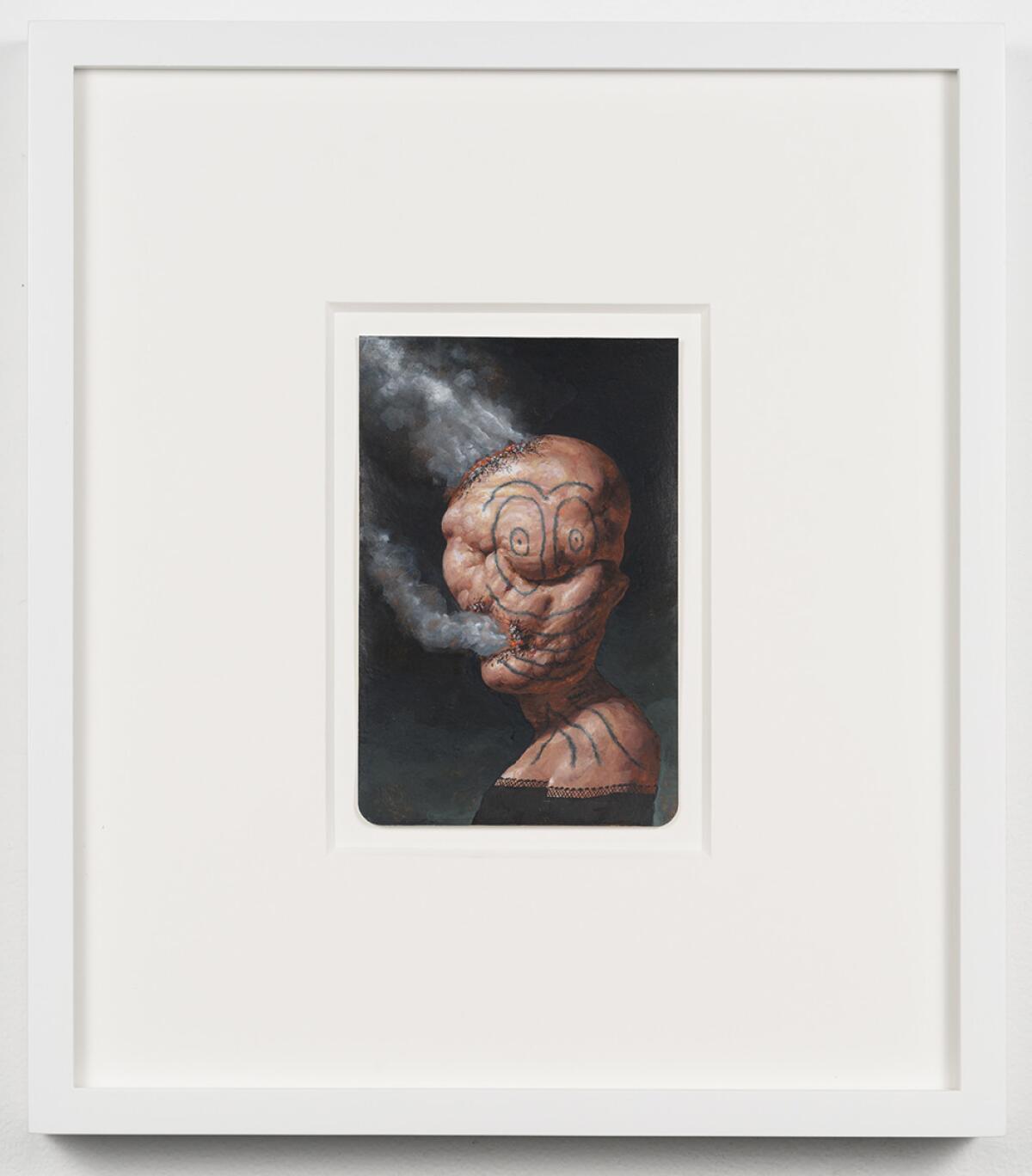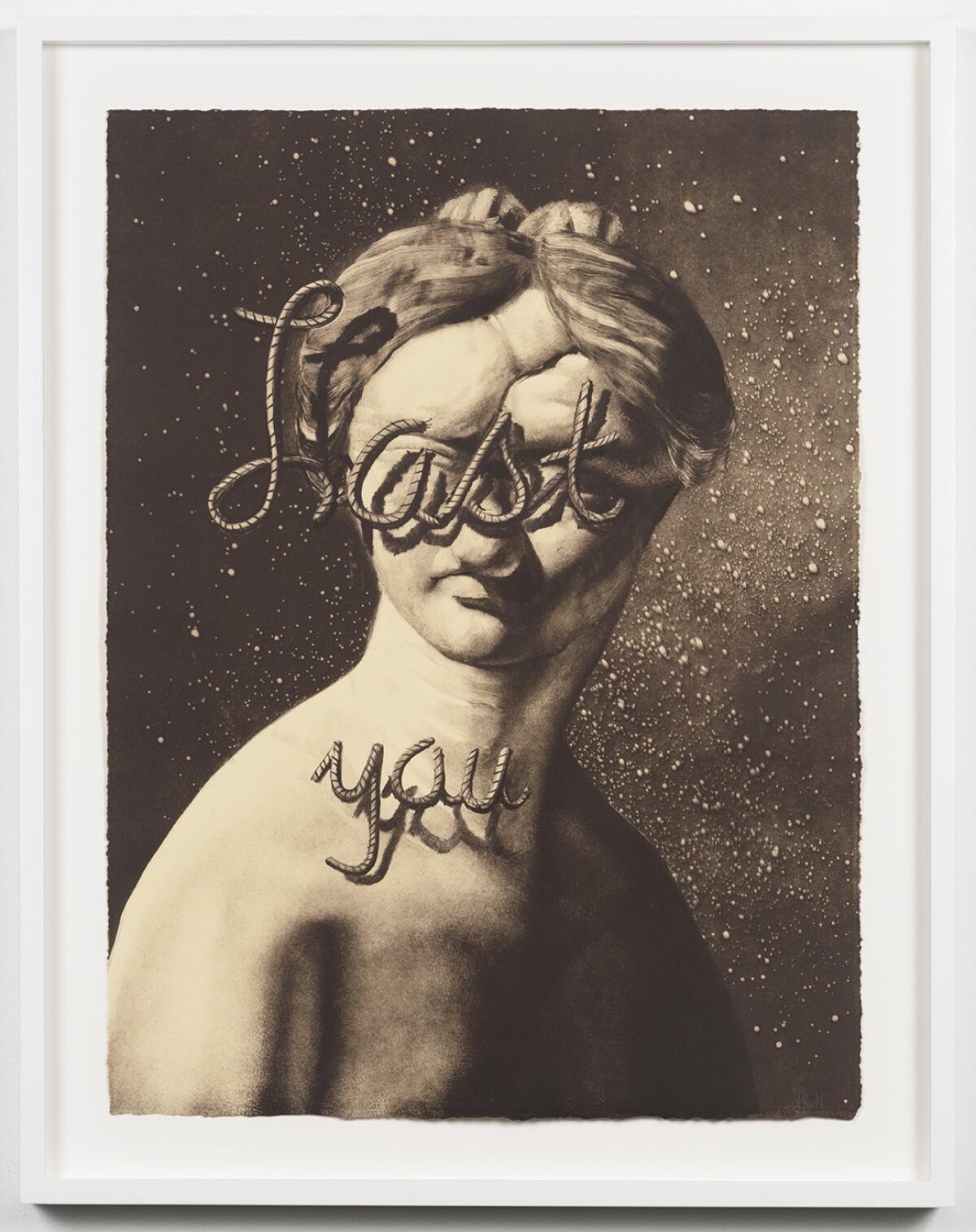Review: Christian Rex van Minnen’s modern tales of male domination, painted like an old master
Christian Rex van Minnen makes icons for an age whose virtues have curdled. The scariest part of his gut-punch paintings, watercolors and monotypes at Richard Heller Gallery in Santa Monica is that that age is ours.
The viciousness that lurks ever closer to the surface of everyday reality — and poisons the atmosphere with toxic dread and deadly anger — erupts from van Minnen’s works with the forcefulness of a volcano. Sparing no one, “Mourning Wood in Liminal Dawn” zeroes in on sex, death and power, particularly as they come together in the behavior of men, fueling fantasies and inspiring actions that are hard to imagine, much less stomach.

SIGN UP for the free Essential Arts & Culture newsletter »
Forget Freud, who thought that sex and death pretty much summed up human experience. To the dynamic duo of Eros and Thanatos, van Minnen adds Power with a capital P — the kind of bare-naked, no-holds-barred brutality of evil characters in comic books or dictators pathologically detached from the last vestiges of their humanity.
Violence follows, naturally and unnaturally. Visitors come face to face with a world more horrifying than horror movies.
In the first gallery, eight intimately scaled portraits are presided over by “The Rise of King Dick,” a larger than lifesize masterpiece of strength run amok, pleasure taken in punishing others and beauty turned into ugliness.
Van Minnen paints like an old master, layering and glazing so that his oils on panel seem to be illuminated from within. Details have been rendered with such fidelity that his paintings seem to be more real than the real thing. If van Minnen belonged to a movement it would be Super-Surrealism.
His gigantic finger-puppet of a king looks so realistic that it seems to be alive — or at least endowed with powers that make your flesh crawl. A single eye, looking out from a malformed face with the inscrutability of the Sphinx suggests that all is not lost — that a glimmer of redemption might lie within.
That is not the case with the eight smaller portraits. Against a shadowy concrete wall, each depicts a decapitated head perched atop a gigantic gummy candy that glistens and glows, like a sci-fi alien.
There’s nothing alien about the men’s faces. Some are old. Some are young. Most are white. All have been executed. But it’s impossible to know the circumstances that led to their deaths. Mob violence? Frontier justice? Kangaroo courts? Jury trials? Movie fantasies? Torture porn?
Adding to the confusion are the crude tattoos that spell out phrases on their faces. With all the sophistication of restroom wall scrawlings, those messages make you wonder if the men chose to use their faces as message boards or if the words were inked as punishment — a modern version of the scarlet letter.
Questions about power and language come to the forefront, as do questions about who speaks for whom, about how meaning shifts as it moves through the world and about painting’s place in it all.
Similar issues take shape in the second gallery, where six monotypes, three watercolors and three oils on linen stir nuance into the queasy cocktail van Minnen so relentlessly serves up. Scholars’ rocks from China, folk tales from Europe and nursery rhymes from the United States expand the parameters of the Brooklyn-based artist’s inquiry into the malignancy of male domination, opening just a sliver of possibility in an otherwise grim reality.
Richard Heller Gallery, 2525 Michigan Ave., Bergamot Station, Santa Monica. Through Dec. 23; closed Sundays and Mondays. (310) 453-9191, www.richardhellergallery.com


See all of our latest news and reviews at latimes.com/arts.
MORE ARTS STORIES:
The art of the tattoo, black and gray style
Applause, and a caution, for UC Irvine’s planned museum
Why your favorite TV show just might be scripted by a playwright
The biggest entertainment stories
Get our big stories about Hollywood, film, television, music, arts, culture and more right in your inbox as soon as they publish.
You may occasionally receive promotional content from the Los Angeles Times.



